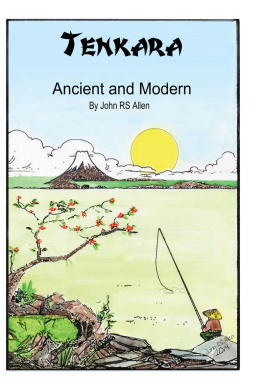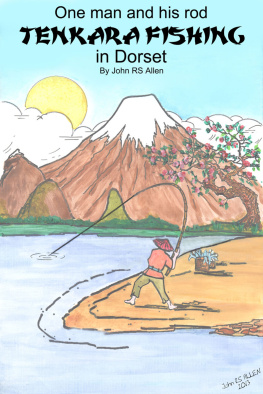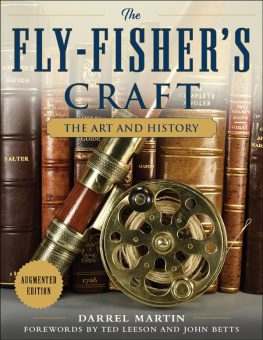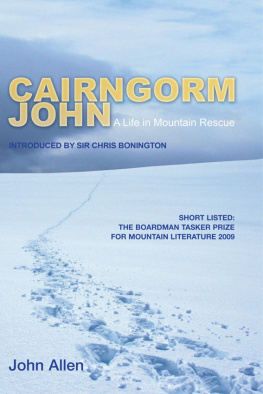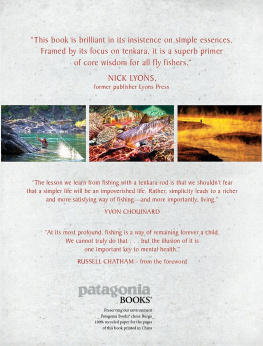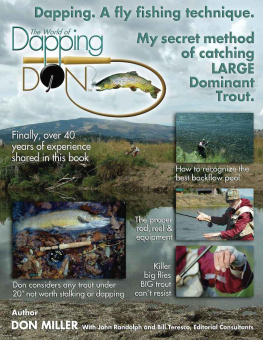Tenkara Ancient and Modern.
By John RS Allen.

Dedication.
To the loving memory of
Watanabe Hideo
1947 to 2013
An honourable gentleman, Tenkara Master and true friend.
Whom, without your kindness, patience and help, I would never have known about Tenkara; Thank you for teaching me Tenkara and making me laugh when I got it wrong.
To Rin and Nanami, thank you for the laughter, it made my Tenkara struggles so very worthwhile. We will be fishing together again one day soon.
To all who suffer with dyslexia - I suffered with dyslexia long before anybody knew what dyslexia was or anyone even wanted to recognise it. I still suffer from dyslexia, it doesnt just go away. Writing isnt my strongest point or something I am comfortable doing. So a special thank you to all those that have helped me get this book into print. As with other books I have written, this book has been a labour of love.
The gods do not deduct from a man's allotted lifespan, the hours he spent fishing . ~ A Babylonian Proverb
I hope you enjoy my book.

Foreword.
The popularity of the traditional Japanese method of fly-fishing, known as Tenkara, is increasing rapidly worldwide. Tenkara, literally meaning from above or from heaven, is a style of pole and line fishing that is in itself simple, relatively inexpensive and most of all fun.
It combines all the skills of fly-fishing, without the need for a conventional fly rod and reel, or complex fly-tying patterns. With the right Tenkara rod, fishing for most of the species of river fish is possible. For those who do not know, a Tenkara rod is similar to a fishing pole. Traditionally rods were bamboo and one piece of around 3.3 m (11 ft) to 4.5m (15 ft) in length, with a hand furled tapered line and a thinner tippet line to the fly and this line can be much longer than the rod length itself.
Modern versions of this rod are made from glass and/or carbon fibre; they are often telescopic and of anything from six to ten sections. Bamboo and split cane versions are available and come in one piece or two, three or four in sections. Tenkara fishing could be seen as the streamlined counterpart to western fly-fishing. The equipment is designed to direct focus to the actual fishing and catching of the fish, and not for any major preoccupation with conventional kit and equipment like in western fishing. Only a Tenkara rod, tapered line, tippet and flies are necessary for Tenkara fishing. This slimmed down kit is easily carried and concentrates the angler on using the bare minimum.
In my last book, Tenkara Dorset A Years fishing the Tenkara style in Dorset, I touched a little on the skills used to do Tenkara fishing. I was quite pleased that the book was so well received and, in answer to all those that contacted me requesting a more detailed book focusing just on the art of Tenkara without the tour of Dorset, well here it is. You will have to forgive some of the repeated information but I hope the extra detail I have added will make your interest in this book worthwhile.
A lot of this book came from actually teaching Tenkara to new anglers and trying to keep it as simple as possible, especially for those who have never done any angling before whatsoever. I think the main emphasis is on doing it and, with Tenkaras simple style, this is easily done no matter what your angling background is or lack of angling knowledge.
I am not in any way a purist of any one aspect of angling. To me all has its place in the sport or hobby and I do, in fact, do all forms of the sport. Its more that there are times in modern life when carrying an enormous amount of kit with you is just not practical, and thats when Tenkara comes in.
Dont get me wrong, true Tenkara isnt some eastern mystical trickery guaranteed to catch a fish; you still have to use your cunning and skills. Fish are a fickle lot, and will not rise to the bait or fly if they are not hungry or just not inclined to do so. It is, after all, still fishing. You still need to find the fish, attract them to your fly, get them to take it, strike and set the hook and then net them.
For me the main benefit of Tenkara is its backpack fishing, light, easy to carry and able to be taken almost anywhere. No fuss, no complicated tackle, just you verses the fish.
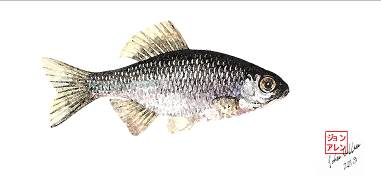
Oily Bitterling
Tenkara in fishing history.
Fishing has existed as a means of obtaining food since the Mesolithic period. During the time of the ancient Egyptians fishermen provided the majority of food. To the ancient Egyptians fishing had become a major means of survival as well as a business venture and some successful fishermen gain very high status. Fish, fishing and the fisherman have also influenced some of Ancient Egyptian religion; i.e. mullets were worshipped as a sign of the arriving flood season.
In ancient Egyptian literature, the method that Amun used to create the world is associated with the tilapia's method of mouth brooding their young, carrying its fry in its mouth. Hatmehyt was a fish-goddess worshipped in the Delta, particularly in the northeast at Mendes. The fish as a divinity is comparatively rare in the Egyptian pantheon, but Hatmehyt's name means "she who is in front of the fishes" or "beginning" making her the earliest fish-goddess to exist when Egypt emerged from the primeval waters.
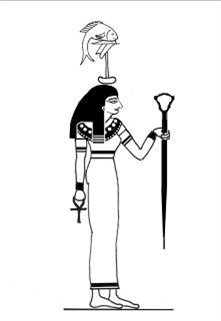
The Goddess Hatmehyt.
(A drawing from a temple carving in Egypt).
Though long pole fishing started in Egypt around two thousand years ago, almost every culture on every continent has had some version of it; all using some form of long rod, a fixed line, natural bait and a hook to catch the fish.
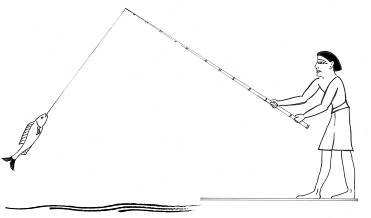
Ancient Egyptian fishing, circa 1300BC.
( A drawing from a tomb carving in Egypt).
The success of long pole fishing was maybe because all you needed was to cut a suitable piece of bamboo or cane, or a supple limb from a tree perhaps, to have a rod and just carry a line and hooks with you to go fishing.
Some cultures, however, adopted using just a long line and hand drawing it on the retrieve, so there was no need then to make or carry a rod. Other cultures developed nets to harvest the fish, others spears, using sharpened wooden spears to stab the fish with. Metal tipped spears and multi-headed spears (tridents) soon appeared.
Even the Ancient Greeks depicted a God of the sea holding a fishing net and a trident.

Poseidon, the Greek god of the sea.
As a historical comparison to modern day fishing, the first ever mention of Fly-fishing was in tablets found in Macedonia that dated from around 200AD; but the first reference to Tenkara fly-fishing in western literature was in 1878 in a book called Diary of climbing Mt. Tateyama by British diplomat, then resident in Japan, Ernest Mason Satow. Satow was also a keen angler, fishing both western fly and Tenkara styles on his travels. Little was known about western fly-fishing until The Treatyse on Fysshynge wyth an Angle was published (1496) within The Boke of Saint Albans attributed to Dame Juliana Berners. The book contains instructions on rod, line and hook making, plus the dressings for different flies to use at different times of the year. Later and probably better known references to fly fishing can be found in Izaak Walton's book The Compleat Angler (1653). By the thirteenth century the first crude reels were starting to appear, these developed and developed to what we have now, but the traditional long pole with fixed line fishing remains in use even today.

